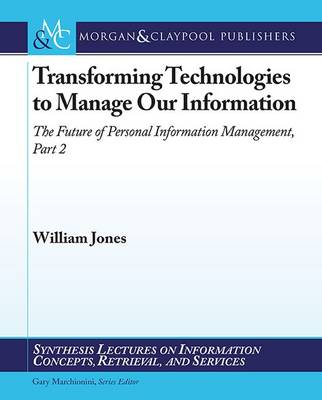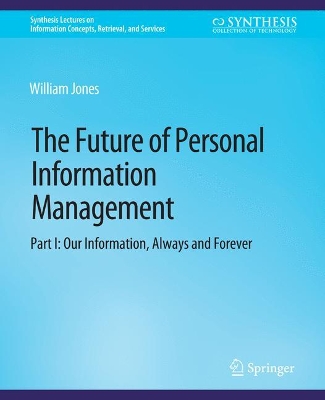Synthesis Lectures on Information Concepts, Retrieval, and Services
3 total works
With its theme, "Our Information, Always and Forever," Part I of this book covers the basics of personal information management (PIM) including six essential activities of PIM and six (different) ways in which information can be personal to us. Part I then goes on to explore key issues that arise in the "great migration" of our information onto the Web and into a myriad of mobile devices.
Part 2 provides a more focused look at technologies for managing information that promise to profoundly alter our practices of PIM and, through these practices, the way we lead our lives.
Part 2 is in five chapters: Chapter 5. Technologies of Input and Output. Technologies in support of gesture, touch, voice, and even eye movements combine to support a more natural user interface (NUI). Technologies of output include glasses and "watch" watches. Output will also increasingly be animated with options to "zoom".
Chapter 6. Technologies to Save Our Information. We can opt for "life logs" to record our experiences with increasing fidelity. What will we use these logs for? And what isn’t recorded that should be?
Chapter 7. Technologies to Search Our Information. The potential for personalized search is enormous and mostly yet to be realized. Persistent searches, situated in our information landscape, will allow us to maintain a diversity of projects and areas of interest without a need to continually switch from one to another to handle incoming information.
Chapter 8. Technologies to Structure Our Information. Structure is key if we are to keep, find, and make effective use of our information. But how best to structure? And how best to share structured information between the applications we use, with other people, and also with ourselves over time? What lessons can we draw from the failures and successes in web-based efforts to share structure?
Chapter 9. PIM Transformed and Transforming: Stories from the Past, Present and Future. Part 2 concludes with a comparison between Licklider’s world of information in 1957 and our own world of information today. And then we consider what the world of information is likely to look like in 2057. Licklider estimated that he spent 85% of his "thinking time" in activities that were clerical and mechanical and might (someday) be delegated to the computer. What percentage of our own time is spent with the clerical and mechanical? What about in 2057?
Part 2 provides a more focused look at technologies for managing information that promise to profoundly alter our practices of PIM and, through these practices, the way we lead our lives.
Part 2 is in five chapters: Chapter 5. Technologies of Input and Output. Technologies in support of gesture, touch, voice, and even eye movements combine to support a more natural user interface (NUI). Technologies of output include glasses and "watch" watches. Output will also increasingly be animated with options to "zoom".
Chapter 6. Technologies to Save Our Information. We can opt for "life logs" to record our experiences with increasing fidelity. What will we use these logs for? And what isn’t recorded that should be?
Chapter 7. Technologies to Search Our Information. The potential for personalized search is enormous and mostly yet to be realized. Persistent searches, situated in our information landscape, will allow us to maintain a diversity of projects and areas of interest without a need to continually switch from one to another to handle incoming information.
Chapter 8. Technologies to Structure Our Information. Structure is key if we are to keep, find, and make effective use of our information. But how best to structure? And how best to share structured information between the applications we use, with other people, and also with ourselves over time? What lessons can we draw from the failures and successes in web-based efforts to share structure?
Chapter 9. PIM Transformed and Transforming: Stories from the Past, Present and Future. Part 2 concludes with a comparison between Licklider’s world of information in 1957 and our own world of information today. And then we consider what the world of information is likely to look like in 2057. Licklider estimated that he spent 85% of his "thinking time" in activities that were clerical and mechanical and might (someday) be delegated to the computer. What percentage of our own time is spent with the clerical and mechanical? What about in 2057?
Personal Information Management (PIM) is the art of getting things done in our lives through information. How do we - can we better - manage our information at home, at school, at work, at play and "@large" in a global community? How do we use information not only to know but also to represent, communicate and effect useful change in the world around us? In the study of PIM, does the search for practical methods with practical impact lead to methods that are "massive open on-line"? Can the ancient practice of storytelling help us better to weave our fragmented information together? In the practice of PIM, how can our information best serve as "near knowledge" - close at hand and, through our information tools, serving in practical ways to extend the knowledge that's "in the head"? If attempts to multitask lead to ineffective, even dangerous, instances of task switching and divided attention, can better PIM help us to realize, instead, opportunities for "multi-goaling" where the same time and effort accomplishes not just one but several goals?
These and other questions are addressed in this third and final book to conclude the series on "The Future of Personal Information Management".Part 1, "Our Information, Always and Forever", covered the fundamentals of PIM and then explored the seismic shift, already well underway, towards a world where our information is always at hand (thanks to our devices) and "forever" on the web. Part 2, "Transforming Technologies to Manage Our Information", provided a more focused look at technologies for managing information. The opening chapter discussed "natural interface" technologies of input/output to free us from keyboard, screen and mouse. Successive chapters then explored technologies to save, search and structure our information. A concluding chapter introduced the possibility that we may see dramatic reductions in the "clerical tax" we pay as we work with our information.
Now in Part 3, "Building a Better World with Our Information", focus shifts to the practical present and to the near future. Part 3 is in three chapters:
These and other questions are addressed in this third and final book to conclude the series on "The Future of Personal Information Management".Part 1, "Our Information, Always and Forever", covered the fundamentals of PIM and then explored the seismic shift, already well underway, towards a world where our information is always at hand (thanks to our devices) and "forever" on the web. Part 2, "Transforming Technologies to Manage Our Information", provided a more focused look at technologies for managing information. The opening chapter discussed "natural interface" technologies of input/output to free us from keyboard, screen and mouse. Successive chapters then explored technologies to save, search and structure our information. A concluding chapter introduced the possibility that we may see dramatic reductions in the "clerical tax" we pay as we work with our information.
Now in Part 3, "Building a Better World with Our Information", focus shifts to the practical present and to the near future. Part 3 is in three chapters:
- Group information management and the social fabric in PIM. How do we preserve and promote our PIM practices as we interact with others at home, at work, at play and in wider, even global, communities? (Chapter 10)
- Designing for PIM in the development of tools and in the selection of teachable (learnable) "better practices" of PIM. (Chapter 11)
- To each of us, our own concludes with an exploration of the ways each of us, individually, can develop better practices for the management of our information in service of the lives we wish to live and towards a better world we all must share. (Chapter 12).
We are well into a second age of digital information. Our information is moving from the desktop to the laptop to the "palmtop" and up into an amorphous cloud on the Web. How can one manage both the challenges and opportunities of this new world of digital information? What does the future hold? This book provides an important update on the rapidly expanding field of personal information management (PIM). Part I (Always and Forever) introduces the essentials of PIM. Information is personal for many reasons. It's the information on our hard drives we couldn't bear to lose. It's the information about us that we don't want to share. It's the distracting information demanding our attention even as we try to do something else. It's the information we don't know about but need to. Through PIM, we control personal information. We integrate information into our lives in useful ways. We make it "ours." With basics established, Part I proceeds to explore a critical interplay between personal information "always" at hand through mobile devices and "forever" on the Web. How does information stay "ours" in such a world? Part II (Building Places of Our Own for Digital Information) will be available in the Summer of 2012, and will consist of the following chapters: Chapter 5. Technologies to eliminate PIM?: We have seen astonishing advances in the technologies of information management -- in particular, to aid in the storing, structuring and searching of information. These technologies will certainly change the way we do PIM; will they eliminate the need for PIM altogether? Chapter 6. GIM and the social fabric of PIM: We don't (and shouldn't) manage our information in isolation. Group information management (GIM) -- especially the kind practiced more informally in households and smaller project teams -- goes hand in glove with good PIM. Chapter 7. PIM by design: Methodologies, principles, questions and considerations as we seek to understand PIM better and to build PIM into our tools, techniques and training. Chapter 8. To each of us, our own.: Just as we must each be a student of our own practice of PIM, we must also be a designer of this practice. This concluding chapter looks at tips, traps and tradeoffs as we work to build a practice of PIM and "places" of our own for personal information. Table of Contents: A New Age of Information / The Basics of PIM / Our Information, Always at Hand / Our Information, Forever on the Web


